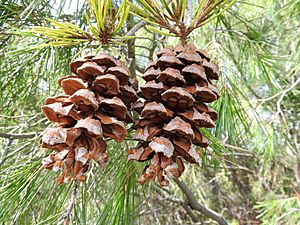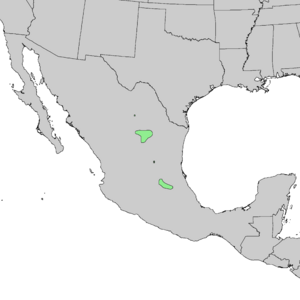Pinus pinceana facts for kids
Quick facts for kids Pinus pinceana |
|
|---|---|
 |
|
| Conservation status | |
| Scientific classification | |
 |
|
| Natural range of Pinus pinceana |
The Pinus pinceana, also known as the weeping pinyon or Pince's pinyon pine, is a special type of conifer tree. Conifers are trees that usually have needles and cones, like pine trees. This tree belongs to the Pinaceae family, which includes many well-known pines, firs, and spruces.
Where Does the Weeping Pinyon Grow?
This unique pine tree grows only in Mexico. When a plant or animal lives only in one specific place, it's called endemic.
You can find the weeping pinyon in several Mexican states. These include Durango, parts of Coahuila, Nuevo León, Zacatecas, San Luis Potosí, Querétaro, and Hidalgo.
Its home stretches a long way, over 750 kilometers (about 466 miles) from north to south! Most of these trees live in dry, desert-like areas. They grow at high elevations, usually between 1,100 and 2,600 meters (about 3,600 to 8,500 feet) above sea level.
What Does It Look Like?
The Pinus pinceana can grow as a small tree or a large shrub. It doesn't always grow very tall.
This tree produces seeds that are safe to eat. However, it doesn't make many seeds, and they are not produced very often.
Is It in Danger?
The weeping pinyon is listed as a "Near Threatened" species by the IUCN Red List. The IUCN Red List is like a global report card that tells us which plants and animals are at risk of disappearing.
"Near Threatened" means that while it's not in immediate danger, it could become threatened in the future. The main reason for this concern is habitat loss. This happens when the natural places where these trees live are destroyed or changed, often by human activities.
See also
 In Spanish: Pince piñón para niños
In Spanish: Pince piñón para niños


